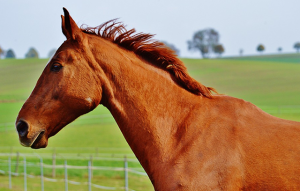 Print a Sign-In Sheet | Spanish Version
Print a Sign-In Sheet | Spanish Version
General safety rules:
- Horses always have the right of way.
- Be aware of and adhere to the speed limit on farm property. Proceed slowly around barns and whenever horses or people are nearby.
- When driving on farm property, always approach workers and horses with caution. Workers leading horses must focus on the horses and may not be aware of your vehicle. Workers operating mowers, trimmers, or other equipment may not hear or see your vehicle approaching.
Safety rules for grooms:
- Always work within your skill and capability level. When attempting a task with which you are unfamiliar, ask for instruction and supervision.
- Approach a horse from the front in a calm and patient manner.
- Horses should always be led from the left side of the horse, maintaining your body position at, or slightly ahead of, the horse’s shoulder.
- Always work from the head toward the tail when treating or grooming a horse. Horses respond in a more relaxed manner when approached from the head first.
- When grooming a horse, tie its head to the stall wall with an appropriate stall tie or shank, or hold the horse’s head with a shank attached to its halter.
- Use appropriate procedures when restraining a horse or handling it for veterinary or blacksmith treatments or other procedures.
- Stand to the side of the horse when applying a twitch.
- Stand to the same side of the horse as the person performing the procedure.
- Stand facing the person performing the procedure so you can see what the person is doing and how the horse is reacting. This view allows you to pull the horse’s head towards you, causing the horse’s hind end to move away from the person performing the procedure should a dangerous situation arise.
- Always have a handler hold a horse when performing any procedure the horse may be unfamiliar with, such as bathing, picking up feet, etc.
- Allow appropriate clearance when moving around horses. Never stand directly behind a horse.
Safety rules at horse sales:
- Horse sales are often fast-paced, and there may be pressure to remove a horse from the barn as quickly as possible upon request from a potential buyer. Do not sacrifice proper handling and safety procedures for the sake of urgency. Always put safety first.
- When a horse is passing you in a barn aisle, always stand on the same side of the aisle as the horse’s handler.
- Always maintain safe spacing between horses, handlers, and other people in the area.
- Never allow horses to pass within a barn aisle.
- Do not approach a horse from behind or reach for a horse while passing.
- Horses tend to be tentative and react differently when presented with new surroundings and procedures at horse sales, especially with young horses, such as weanlings and yearlings. Take extra care while horses adjust to their new surroundings.
Safety rules for maintenance personnel:
- Always check and inspect equipment before beginning a task to ensure it is in safe working order.
- Follow all safety recommendations of the manufacturer.
- If you are unsure of how to properly operate equipment, consult your supervisor.
- Wear appropriate protective equipment for the job.
- Be aware of the surroundings where you are working and your proximity to horses and vehicles. When operating mowers, tractors, trimmers, and other equipment, you may not hear approaching vehicles.
Trimmer rules and regulations:
- Safety glasses must be worn at all times.
- Do not leave a trimmer, gasoline, or string in any field. Do not lean string trimmers on a fence.
- Go to the nearest barn or ask someone to call a supervisor if help is needed. Do not try to fix or adjust a string trimmer yourself unless properly trained to do so.
- If horses are being led to or from a barn, turn the trimmer off.
- Check with someone inside a barn before string trimming around it.
- Clean the trimmer at the end of each week and blow it off daily.
- Do not throw trimmer string on the ground. Discard it in the trash.
- Do not throw tree limbs into fields. Put them into a tree pen and inform a supervisor so arrangements can be made to pick up the limbs.
- As a trimmer can throw debris, be aware of vehicles and people in the area.
Riding mower rules and regulations:
- Check engine oil each day before starting the mower.
- Do not try to repair a mower unless properly trained to do so.
- Mower blades should be sharpened by appropriate personnel as scheduled.
- Mowers should have the oil changed by appropriate personnel as scheduled.
- Do not mow inside fences with horses in the field unless approved by a supervisor.
- Do not run over paper or other trash.
- Do not blow grass clippings in shrub beds or tree rings.
- Do not hit or get close enough to hit any trees.
- Be sure all guards and safety features are in their proper place and position.
KEMI does not assume liability for the content of information contained herein. Safety and health remain your responsibility. This information is to be used for informational purposes only and not intended to be exhaustive or a substitute for proper training, supervision, or manufacturers’ instructions/recommendations. KEMI, by publication of this information, does not assume liability for damage or injury arising from reliance upon it. Compliance with this information is not a guarantee or warranty that you will be in conformity with any laws or regulations nor does it ensure the absolute safety of any person, place, or object, including, but not limited to, you, your occupation, employees, customers, or place of business.

